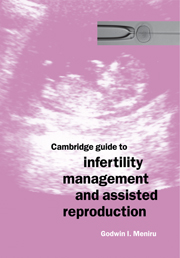Book contents
- Frontmatter
- Contents
- Preface
- Foreword
- Acknowledgements
- Introduction
- 1 The male reproductive system
- 2 The female reproductive system
- 3 Fertilization, implantation and early development
- 4 Male factor problems
- 5 Female factor problems
- 6 Evaluation of the infertile couple
- 7 Medical and surgical treatment of infertility
- 8 Conventional in-vitro fertilization treatment
- 9 Intracytoplasmic sperm injection
- 10 Surgical sperm retrieval
- 11 Intratubal replacement of gametes and embryos (GIFT, ZIFT)
- 12 Intrauterine insemination
- 13 Cryopreservation of gametes, ovarian tissue, testicular tissue and embryos; frozen embryo replacement
- 14 Assisted hatching
- 15 Preimplantation diagnosis of genetic disease
- Appendix: Acronyms in assisted reproduction technology
- Index
9 - Intracytoplasmic sperm injection
Published online by Cambridge University Press: 11 September 2009
- Frontmatter
- Contents
- Preface
- Foreword
- Acknowledgements
- Introduction
- 1 The male reproductive system
- 2 The female reproductive system
- 3 Fertilization, implantation and early development
- 4 Male factor problems
- 5 Female factor problems
- 6 Evaluation of the infertile couple
- 7 Medical and surgical treatment of infertility
- 8 Conventional in-vitro fertilization treatment
- 9 Intracytoplasmic sperm injection
- 10 Surgical sperm retrieval
- 11 Intratubal replacement of gametes and embryos (GIFT, ZIFT)
- 12 Intrauterine insemination
- 13 Cryopreservation of gametes, ovarian tissue, testicular tissue and embryos; frozen embryo replacement
- 14 Assisted hatching
- 15 Preimplantation diagnosis of genetic disease
- Appendix: Acronyms in assisted reproduction technology
- Index
Summary
Introduction
The management of male factor infertility has until recently been very problematic, inefficient and not very rewarding. This derives partially from the fact that the cause of depressed semen parameters may be unknown in a large proportion of cases. Even where a cause is found the subnormal testicular function or the genital tract lesion is invariably irreversible; many medical and surgical treatment methods have failed to provide a cure for male factor problems that translate into improved pregnancy rates. With the introduction of assisted conception technology into clinical practice, attempts have been made to discover more efficient methods of treating infertile couples with male factor problems (Table 9.1).
Artificial insemination with sperm from the partner has been found useful in some couples with mild to moderate depression of semen parameters; intrauterine insemination with washed partner sperm following mild superovulation is associated with an improved pregnancy rate provided that the total motile sperm count after sperm washing is greater than one million (Ombelet et al., 1995; Campana et al., 1996). Following early successes in women with tubal infertility, conventional in vitro fertilization (IVF) was evaluated for use in male factor infertility cases. Again, while it was of some use in some cases, there was a tendency towards failed fertilization or poor fertilization rates when the sperm abnormality was moderate or severe.
- Type
- Chapter
- Information
- Publisher: Cambridge University PressPrint publication year: 2001



